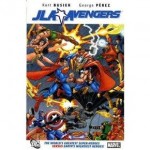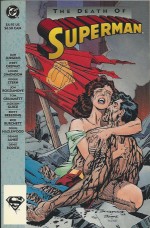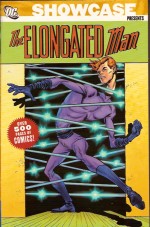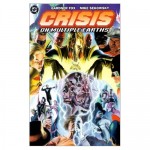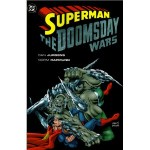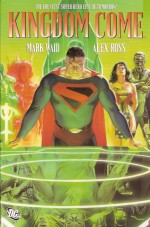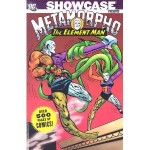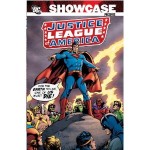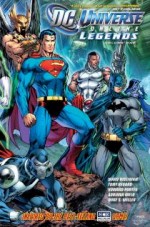
By Marv Wolfman, Tony Bedard, Howard Porter, Adriana Melo, Mike S. Miller & various (DC Comics)
ISBN: 978-1-4012-3218-4
No matter how much nostalgic old geezers like me might wish it otherwise, most of the classic American Superhero characters have far outgrown their static 2-Dimensional origins and are far more creatures of the screen now: Movie, TV or Computer – and often all three.
As such it’s no longer odd to see such veteran pen-and-ink superstars return to funnybook pages as their own spun-off avatars, in adventures where they are transformed, sometimes bastardised versions of (to me at least) their “true†selves.
One of the better examples in recent years of this chimerical commercial alchemy was a phenomenal Armageddon Epic based on a computer game starring the Justice League of America which actually surpassed much of the company’s contemporary output vis á vis thrills, chills and old fashioned comicbook class…
DC Universe Online Legends first appeared as a 27-issue series running from March 2011 to May 2012, based on a Massively Multiplayer Online Role-Playing Game (or MMORPG for those computerati already in the know). It featured the final triumph of paramount Superman villains Lex Luthor and Brainiac as the starting point for a blistering “Twilight of the Gods†scenario and this first compilation volume gathers #1-7 of the fortnightly series and also includes the “issue #0†which came free with the game itself.
‘Prelude’ by Tony Bedard and artists Oliver Nome, Michael Lopez & Livio Ramondelli, starts the ball of doom rolling as cosmic marauder and collector of civilisations Brainiac launches a harrowing assault on Metropolis, and the JLA – Aquaman, the Martian Manhunter, Wonder Woman, Flash, Green Lantern, Superman and Batman – mobilise to stop him. Unbelievably they fail…
Marv Wolfman, Bedard, Howard Porter, John Livesay, Adriana Melo & Norman Lee then kick things into high gear with ‘Legendary’ as in the near-future Luthor, now more machine than man, finally slays his life-long nemesis in the ruins of a ravaged Earth and leaves the Kryptonian to rot amidst the corpses of his fellow fallen heroes.
The obsessive villain had long ago entered into a devil’s bargain with Brainiac and now intends to rule the remains of Earth, but soon discovers that the Scourge from Space (an implacable, unstoppable planetary plunderer who has destroyed most of the civilised universe and even crushed the immortal Green Lantern Corps) has played him for a fool and now acts to assimilate the planet’s remaining valuable resources – which includes Luthor’s mind – and eradicate the gutted shell…
Realising too late the horrific mistake he’s made, Lex swiftly formulates a plan to undo the damage he’s caused and repay Brainiac for his treachery. The first step is to gather all the surviving metahumans – heroes and villains all oblivious to the fact that Luthor has already slain their greatest champions – into an attack force whilst the infuriated evil genius prepares to unmake recent history…
Meanwhile, several years earlier, a fully human and hero-hating Lex Luthor is contacted by a drone from deep space and enters into a sinister alliance with the alien reiver whose mutual dream is to destroy Superman forever…
Scripted by Bedard, ‘Control’ finds Luthor directing his rag-tag team of deeply suspicious resistance fighters (Dr. Fate, Mr. Freeze, August General in Iron, Solomon Grundy, Power Girl, Cheetah, Blue Beetle, Black Canary and the Atom) in forays against the extraterrestrial Exobyte nanomachines and robot drones disassembling the world, unaware that they were secretly produced in the malign magnate’s factories years before…
In those long-ago days, Brainiac’s probing attack has captured the Daily Planet building in Metropolis. The alien inquisitor apparently needs test samples of base-line humanity to examine before he can calibrate his ghastly devices and begin harvesting Earth’s metahuman resources…
In the furious future the schemer’s pawns continue their missions utterly unaware that, to ultimately save humanity, Luthor plans to sacrifice them all…
Wolfman, Mike S. Miller, Melo & Norman Lee disclose the master manipulator’s ‘Betrayal’ of his team after Power Girl discovers the corpse of her cousin Superman and the resistors demand vengeance. After first setting a horde of bloodthirsty villains upon them, Lex then murderously saves his squad of heroic stooges, pleading repentance and offering to surrender to justice once earth has been saved.
Of course, he’s still lying…
In the present, whilst Lois Lane, Jimmy Olsen and Perry White explore their options as captives of Brainiac, an increasingly unstable and impatient Superman chafes at the JLA’s caution, unaware that the cosmic conqueror is planning an imminent and devastating sneak-attack of the League’s satellite citadel…
Bedard & Porter take the creative lead for the all-action episode ‘Strike Force’ as, in the world of today, the Justice League battle valiantly but futilely against swarms of Exobytes which readily bypass all their defences and begin stealing the powers of the embattled defenders. In the Foredoomed Tomorrow, Luthor leads his duped disciples in a fool’s errand onto Brainiac’s ship, tasked with recovering a city-full of yellow power rings, originally used by the minions of renegade Green Lantern Sinestro, whilst the master manipulator himself plans to confront the invader face-to-face…
Wolfman & Miller produced the shocking ‘Three Minutes’ in which the JLA lose their holding action and have to abandon their orbital Watchtower to the Exobytes – but not every hero escapes – whilst in the future the raid has gone equally badly and one of Luthor’s key pawns is maimed, leading to time-split ‘Downfall’ (Bedard, Porter, Livesay & Pop Mhan) for both teams of champions.
In our time, after warning Luthor to get out of the city, Brainiac casts the Watchtower out of orbit and aims it at what’s left of Metropolis, with the Man of Steel desperately attempting to rescue his stranded comrades and simultaneously save his hometown, whilst in days to come Luthor, Atom and Black Canary split up…
The heroes now carry a canister of retrieved Exobytes holding all the planet’s harvested super-powers – enough to turn all Earth’s survivors into metahuman warriors – but the disgraced Machiavelli who guides them is determined to personally destroy the alien who played him for a fool…
In the past, Superman narrowly saves Metropolis, but fallout and debris from his last-ditch attempt falls on the fleeing Luthor, crushing his body whilst in the future the cyborg genius at last battles Brainiac but is easily and resoundingly beaten…
This first explosive chronicle concludes with the revelation that Luthor has a secret ally as, in the untitled seventh chapter (by Wolfman, Porter & Livesay), a Batman also more mechanoid than mortal manhunter acts with a band of freshly created superheroes to use the Exobytes in a bold and radical manner.
Rather than boost the dying earth’s meagre surviving population with the stolen super-powers, what if the nanobots were taken back in time and used to turn an entire overpopulated earth into a planet of “metas†before Brainiac’s invasion beachhead was established?
Of course even here in Earth’s final hour, Luthor cannot resist betraying his comrades but has again underestimated the sheer dogged determination of the demi-digital Dark Knight…
This high-octane Fights ‘n’ Tights shocker also includes a selection of covers and variants by Carlos D’Anda, Jonny Wrench, Jim Lee, Scott Williams, Alex Sinclair, Ryan Sook, Ed Benes, Randy Mayor, Jorge Gonzalez, Tony Aviña & Carrie Strachan as well as pages of behind-the-scenes character, tech and scenario designs and sketches from the game iteration.
Fast, furious, spectacular and devilishly devious, this is a sharp, no-nonsense graphic Götterdämmerung saga that will delight traditional comicbook action fans as well as all those young plug-in babies of the digital age.
© 2011 DC Comics. All Rights Reserved.

